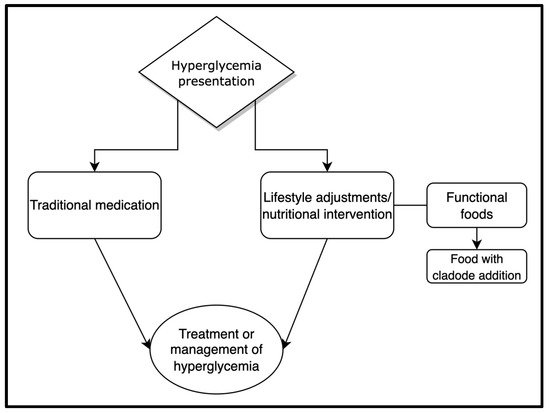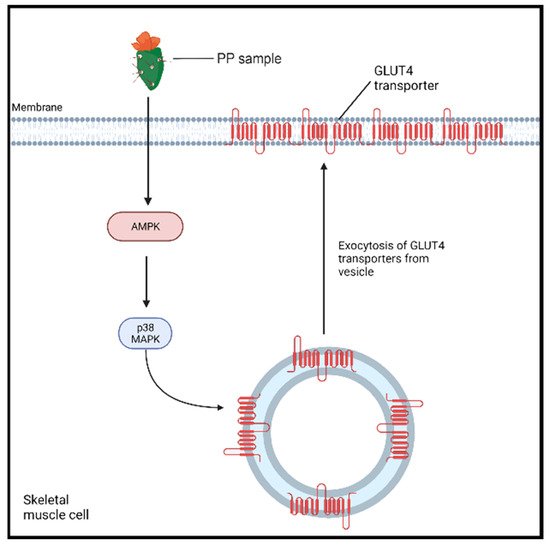The consumption of prickly pear (PP; Opuntia spp.) cladodes was reported to exert hypoglycemic effects, making it a potential cost-effective nutritional intervention for the management of T2DM. Several studies have demonstrated that the consumption of prickly pear cladodes and the related products reduced post-prandial glucose levels. The cladodes’ high fiber content may be implicated in improving glycemic control, by affecting glucose absorption and effectively slowing its release into the blood circulation. Given these potential hypoglycemic effects, prickly pear cladodes may represent a potential functional food ingredient to improve glycemic control and counter the negative metabolic effects of the modern Western diet.
1. Introduction
The prevalence of obesity is increasing worldwide and continues to represent a major health concern [
1], affecting over a third of the global population [
2]. Obesity is identified as a major risk factor for a multitude of non-communicable diseases, in particular for the development of cardiovascular disease (CVD) and type 2 diabetes mellitus (T2DM) [
3]. Insulin resistance is the link between obesity and T2DM and is characterized as a blunted response of insulin tissue targets to insulin that, in concert with impaired pancreatic β-cell dysfunction, contributes to hyperglycemia [
4]. The long-term consequences of untreated hyperglycemia and insulin resistance include the onset and development of diabetic neuropathy, nephropathy, retinopathy, and several other cardiovascular complications [
4]. Additionally, T2DM is emerging as a risk factor for several neurodegenerative diseases [
5,
6].
It is well established that adequate nutritional interventions can exhibit beneficial outcomes on glycemic control. These include adherence to different dietary patterns, such as the Mediterranean diet [
12], and the inclusion of different functional food products as a part of a healthy and balanced diet [
3]. Furthermore, the concept of functional foods is a relatively new model that may assist in the management of several health issues, such as hyperglycemia (
Figure 1) [
13,
14,
15,
16]. Among these functional food products, the cacti (and its products) commonly referred to as “prickly pear” (PP;
Opuntia spp.) cladodes [
17], may represent a promising nutritional approach for the management of hyperglycemia [
18,
19,
20,
21]. Although these cladodes have been used as a traditional treatment for T2DM in Mexico [
22], the use of
Opuntia spp. as a basis of functional food products for the management of a range of health conditions has been proposed only relatively recently [
23,
24,
25].
Figure 1. The general approaches of the management and treatment of hyperglycemia, which include the use of traditional medication with/or lifestyle adjustments and nutritional intervention (the use of functional foods) [
3,
17,
26].
3. Etiology of Type 2 Diabetes
The etiology of T2DM and the associated hyperglycemia can be broadly attributed to the progressive impairment of insulin sensitivity, in concert with the dysfunction of pancreatic β-cells [
27,
28]. Insulin resistance is largely induced by metabolic inflammation and ectopic lipid accumulation, secondary to defective lipid metabolism and mitochondrial dysfunction [
5,
29], all of which are associated with obesity [
27,
30]. The ectopic lipid accumulation and, particularly, of intermediate lipotoxic metabolites, primarily the ceramides, are proposed to be the key mechanisms and metabolites involved in the development of insulin resistance [
5]. These lipotoxic metabolites have been implicated in impairing insulin signaling, primarily by hindering protein kinase B (AKT) phosphorylation [
27]. Furthermore, a positive energy balance, which underlies obesity, induces an excess of energy stored in adipose tissue in the form of triglycerides. In turn, adipocyte hypertrophy results in adipocyte dysfunction, characterized by the increased secretion of proinflammatory cytokines, such as TNF-α and Il-6, which is further fueled by the infiltration of the adipose tissue by immune cells, including macrophages. This contributes to the low-grade chronic inflammatory status that is typical of obesity and represents a crucial link between obesity and insulin resistance [
31]. Although insulin resistance is initially compensated for by insulin hypersecretion once β-cell islet dysfunction arises, this compensatory response eventually becomes compromised, leading to the development of T2DM.
4. Prickly Pear Cacti: General Information and Composition
The PP cacti are a resistant desert species native to the American regions, and, due to their high adaptability,
Opuntia spp. have spread to other regions around the globe, such as Europe [
32] and Australia [
13,
17,
33]. The annual production of PP exceeds 400,000 metric tons in Mexico alone [
34], where it is traditionally consumed as a vegetable [
32]. Furthermore, the cladodes are typically consumed, whether broiled, blended, or as a juice after the removal of the spines [
35,
36].
The main components in cladodes are carbohydrates (38% dry weight (d.w.)), proteins (11% d.w.) and water (83%; 5:1 biomass to water ratio) [
37,
38]. The nutritional composition may differ among
Opuntia spp., dependent on the specimen’s age and environmental factors, such as the cultivation season and geographical position [
38]. The primary polysaccharide in cladode is mucilage, an ingredient commonly used in the food industry as an additive and an emulsifier [
38]. Furthermore, an analysis of cladode extract indicated the presence of several phytochemicals, mainly polyphenols and phenolic acids [
36], all of which have been implicated in certain beneficial health outcomes particularly related to the management of CVD [
39,
40,
41,
42].
5. Anti-Hyperglycemic Effect of the Prickly Pear Cladode
The findings from several different randomized controlled trials (
Table 1) have indicated a potential (mainly acute) hypoglycemic effect immediately following the consumption of cladodes. A study conducted by Frati et al. [
19] aimed to evaluate the potential hypoglycemic effects of different cladode preparations (500 g; broiled, blended and broiled, blended crude, and heated, blended crude) after ingestion, in participants diagnosed with T2DM (
n = 8). It was observed that all methods of cladode preparation resulted in an acute reduction of blood glucose at 120 and 180 min following the cladode intake (
p < 0.01). The peak hypoglycemic effect of the cladode intervention observed a reduction ranging from 23.3 ± 4.4 mg/dL to 25.4 ± 14.3 mg/dL. No difference was noted in the hypoglycemic effectiveness between the preparation methods of the cladode (
p > 0.05). A similar outcome was also observed in an earlier study by Frati-Munari et al. [
43].
6. Potential Hypoglycemic Mechanism of Action
Cladode consumption has been observed to exert acute hypoglycemic effects [
17,
18,
19]; however, the exact mechanisms of its action are still not completely elucidated [
17]. A study conducted by Leem et al. [
47] investigated the underlying mechanism of the in vitro antidiabetic effect of
Opuntia ficus indica var.
saboten cladode powder extract in rats with L6 myoblasts [
47]. The addition of the extract produced an increase in adenosine monophosphate-activated protein kinase (AMPK) and p38 mitogen-activated kinase (MAPK) activities (
p < 0.05) within the myoblasts (
Figure 2) compared to control cells (100 nM insulin). The latter enzymes are implicated as cellular energy sensors that promote the transport of glucose to skeletal muscle. The activation of AMPK promotes its interaction with p38 MAPK, which, in turn, induces the translocation of glucose 4 transporters (GLUT4) to the cell membrane [
47,
48]. This causes an increase in the available GLUT4 transporters on the plasma membrane, leading to an 11.7% increase in glucose uptake following the treatment when compared to a control. To confirm these findings, AMPK and p38MAPK were inhibited, which largely abolished the effects of the cladode extract treatment on the L6 myotubes’ glucose uptake. Interestingly, AMPK activation noticeably protects against hepatic lipotoxicity, a known contributor to the pathogenesis of T2DM, in cultured hepatocytes and animal liver [
49].
Figure 2. The proposed PP-enhanced AMPK pathway for an antidiabetic effect. PP sample (Opuntia ficus-indica var. saboten (OFS) extract full) enhances the activity of AMP-activated protein kinase (AMPK), which triggers the activation of p38 mitogen-activated kinase (MAPK) [
47]. The latter enzyme induces the exocytosis and translocation of GLUT4 to the plasma membrane, enhancing the influx of glucose into the cell.
The modulation of the gut microbiota and its contribution to metabolic disease is well established, and detailed information is described elsewhere [
54,
55]. Some of the potential mechanisms underlying the regulation of blood glucose metabolism can also be ascribed to the gut microbiota via the modulation of inflammation, gut permeability, and insulin sensitivity in several mammalian models.
7. Prickly Pear Cladode as a Functional Ingredient for Hyperglycemia Management
Foods are no longer only being consumed to promote satiety or meet nutritional requirements but are increasingly being used to potentially prevent or manage chronic diseases in the form of functional foods [
62,
63]. A food is deemed to be functional if it constructively improves the health of an individual beyond its “normal” nutritional value [
64]. These food products are also becoming more popular, as is evident from a global market share now estimated to be over USD 180 billion, with an 8% annual growth [
65]. As such, new and/or improved functional foods are becoming a valuable commodity of economic and health interest alike.
With the general increase in the popularity of functional foods, the application of cladodes in different food products could be seen as advantageous due to their potential beneficial health properties. One of the proposed food candidates for cladode addition is pasta, a popular dish consumed by many around the world.
8. Adverse Effects of Prickly Pear Consumption
The reported adverse effects of cladode consumption in the literature remain scarce. Nonetheless, a documented case study of low colonic obstruction in a patient was attributed to PP seed intake. Furthermore, a systematic review investigating gastrointestinal seed bezoar cases revealed that 28 individuals had phytobezoars induced by PP consumption [
71]. A bezoar is a persistent indigestible mass accumulating within the gastrointestinal tract, with the most common presenting symptoms being rectal pain, intestinal obstruction, and constipation [
72]. Although the occurrence of PP-induced bezoar is rare, individuals should be vigilant if any pertinent symptoms arise, especially given the association of T2DM with gastroparesis. A few anecdotal cases have been reported, with subjects presenting with chronic diarrhea and encopresis that was attributed to PP intake [
73]. It would also be advisable that individuals with low blood glucose may want to abstain from PP consumption as it may exacerbate their hypoglycemia.
10. Conclusions
Several studies showed reductions in blood glucose levels in individuals following the intake of cladode, particularly in an acute study design. The mechanism(s) by which the cladode exerts its hypoglycemic activity remains undefined; however, various mechanisms have been proposed. These include a cladode-induced AMPK pathway, ultimately stimulating the translocation of GLUT4 transporters to the membrane. Another mechanism by which cladode exerts its activity is by affecting the gut microbiota, ultimately altering the glucose metabolism to reduce glucose peaks. Additionally, the nopal may potentially suppress the inflammatory effect of LPS, thereby inhibiting LPS-induced insulin resistance and glucose intolerance. Given its potential anti-hyperglycemic effect, the use of PP in the production of functional foods, such as functional pasta, may represent a promising nutritional tool to manage hyperglycemia.
This entry is adapted from the peer-reviewed paper 10.3390/medicina58020300


